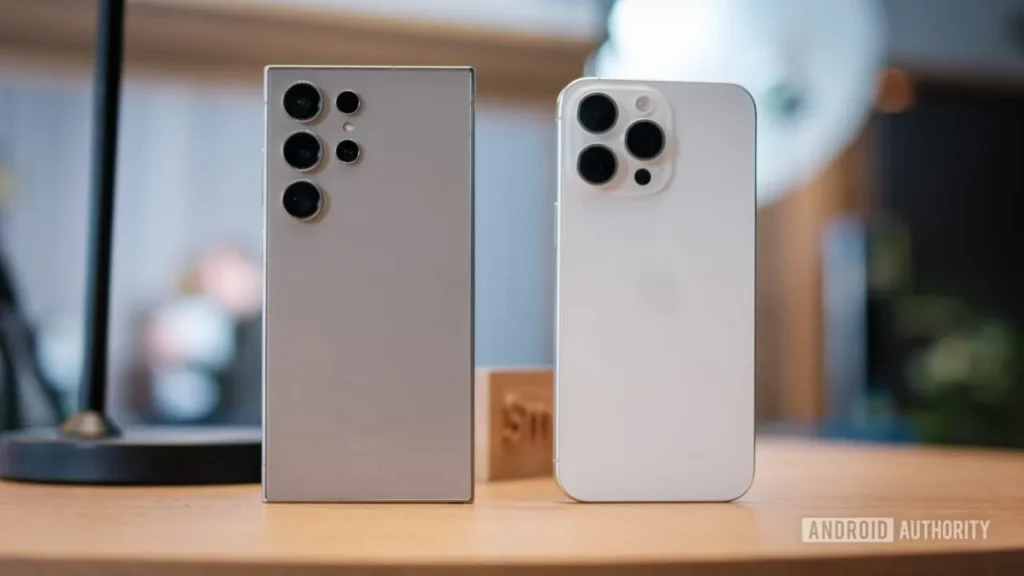In 2025, the battle between iPhone vs Android continues to shape the smartphone market. Both platforms have evolved significantly, with cutting-edge features, improved performance, and diverse ecosystems. But how do they stack up against each other? In this iPhone vs Android comparison, we’ll break down the strengths and weaknesses of each platform to help you make an informed decision. Whether you’re an Apple fan or an Android enthusiast, read on to discover which system works best for you.

Performance and Speed – iPhone vs Android Comparison
When it comes to performance, both the iPhone and Android phones are powerhouses, but the differences are notable.
iPhone’s A-Series Chip vs Android’s Snapdragon and Exynos Chips.
iPhones are equipped with Apple’s A-series chips, which are designed specifically for iOS devices. These chips provide seamless performance, faster processing speeds, and optimized battery efficiency. For example, the A17 Bionic chip in the latest iPhone 15 delivers exceptional power for demanding apps and multitasking. In contrast, Android devices often use Qualcomm Snapdragon or Samsung Exynos processors. While Snapdragon chips are top-tier and deliver impressive performance, the fragmentation of Android chipsets can lead to varying levels of performance across different devices.
Overall Speed and Responsiveness.
While iPhones tend to maintain a smooth, lag-free experience due to their optimized hardware and software integration, Android offers more variety. High-end Android devices, especially those with Snapdragon 8 Gen 2 chips, deliver comparable speed, but lower-end Android phones may struggle with performance.
Camera Quality – iPhone vs Android Comparison.
In 2025, smartphone cameras are more important than ever. Whether you’re a budding photographer or someone who loves to share photos on social media, both the iPhone and Android offer exceptional camera capabilities.
iPhone’s Consistent Camera Performance.
The iPhone’s camera system is often praised for its consistency. Apple prioritizes color accuracy, natural-looking photos, and video recording features. With the iPhone 15, you get a 48MP camera with Deep Fusion technology, ensuring high-quality shots in any lighting
Android’s Innovation and Camera Variety.
Android, however, offers a broader range of camera configurations, thanks to the variety of manufacturers. Google Pixel phones, for example, excel in software-driven camera enhancements, while Samsung Galaxy phones often have higher megapixel counts (up to 108MP in some models). Android phones also provide more flexibility in terms of settings and manual adjustments.

Software and Updates – iPhone vs Android Comparison.
iPhone’s Regular Software Updates.
Apple’s approach to software updates is one of the strongest points in its favor. iPhones receive regular updates directly from Apple, ensuring that even older models get new features, security patches, and improvements for several years.
Android’s Fragmented Update System
In comparison, Android suffers from a more fragmented update system. While flagship phones like the Google Pixel and Samsung Galaxy devices receive timely updates, many budget and mid-range phones may have to wait longer for software updates — or never receive them at all.
Battery Life – iPhone vs Android Comparison
iPhone’s Efficient Battery Management
Apple has improved battery life in recent years by optimizing iOS for better efficiency. iPhones tend to have great battery management, especially with the A17 Bionic chip, which is designed to conserve power without sacrificing performance. iPhones are also compatible with MagSafe charging for fast wireless charging
Android’s Varied Battery Performance
On the Android side, battery life varies widely depending on the device and its battery capacity. Flagship Android phones typically come with fast charging and reverse wireless charging capabilities. For instance, some Samsung Galaxy phones come with 45W fast charging, allowing you to power up quickly.
Price and Value – iPhone vs Android Comparison
Price is one of the most significant differences in the iPhone vs Android comparison. iPhones, particularly the latest models, are generally more expensive than Android phones. However, Apple offers long-term software support and resale value, making them a solid investment.
Android Offers More Budget Options
Android offers a wider range of devices at varying price points. Whether you’re looking for a budget-friendly phone or a high-end flagship, you can find an Android phone that fits your budget. Brands like OnePlus, Xiaomi, and Realme provide great devices at more affordable prices.
Conclusion: iPhone vs Android Comparison – Which Is Right for You?
Both iPhone and Android offer distinct advantages, and the choice between them ultimately depends on your preferences and needs. If you value simplicity, consistency, and long-term software updates, the iPhone is an excellent choice. On the other hand, if you prefer customization, variety, and a broader range of options, Android might be the better fit.
In the end, whether you choose iPhone or Android, both platforms continue to improve with each iteration. So, which one will you choose?
